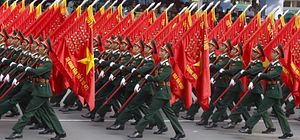HO CHI MINH CITY—ON April 30, 1975, the army of communist North Vietnam took Saigon, toppled the government of South Vietnam, and brought two decades of American military involvement in Vietnam to an end. Today the fall of Saigon is defined, at least in the west, by two indelible images. The first, taken by the late Dutch photographer Hugh Van Es, shows a line of desperate Vietnamese trying to board an American helicopter from a rooftop in downtown Saigon. The other image was captured on film by the Australian journalist Neil Davis: It showed a North Vietnamese tank, bristling with diminutive bo doi infantry, smashing through the cast-iron gates of the Presidential Palace, climbing to its roof, and running up the standard of liberation.
In their own way, both images were a fittingly shambolic testament to a war that was hastily conceived, poorly planned, and conducted with brutal indifference to the people of the country that it ostensibly sought to save. The U.S. intervention in Vietnam cost the lives of around 3 million Vietnamese and 58,000 Americans, devastating the country’s physical infrastructure and setting its development back by decades.
Forty years on, those who are old enough still remember the mixture of fear, relief and uncertainty that marked South Vietnam’s final days and the end of the war. “On April 30 there were tanks in the street here. Saigon was very chaotic,” said Nguyen Quoc Kien, 48, the owner of a coffee shop in Cholon, the Chinese district of Saigon. “I remember a girl – she was shot at a roundabout because she was a Viet Cong.” Pham Van Minh, 67, a former engineer in the South Vietnamese navy, remembered an eerie calm. “We were very happy to have peace, to have the war finished,” he said, crossing his fingers and jabbing them to emphasize the closing of one era and the beginning of another.
Last month, Saigon – almost no one here calls it by its official name – marked the 40th anniversary of the great communist victory with lavish parades and reenactments. In preparation, the center of town was plastered with even more communist propaganda posters than usual. These blared the familiar socialist imagery: swooping doves, charging tanks, Uncle Ho etched on slabs of blue and red, beaming like a communist Colonel Sanders.
For years Vietnam’s communist leader was the most potent “brand” in the city bearing his name. But Saigon today is a very different place.

































